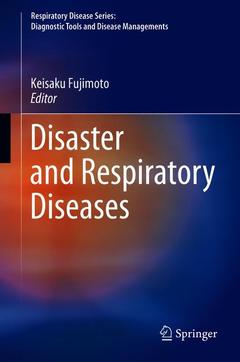Disaster and Respiratory Diseases, 1st ed. 2019 Respiratory Disease Series: Diagnostic Tools and Disease Managements Series
Coordonnateur : Fujimoto Keisaku

Disaster and Respiratory Diseases is a valuable resource for all medical staff, including physicians involved in primary care, respiratory medicine and infection control and emergency medicine, as well as respiratory surgeons. Itis also useful to national and regional governments concerned about anti-disaster measures.
?
Part I : Respiratory Injury Directly Induced by a Disaster.- Chapter 1: Dust, asbestos, and sludge exposure: What kinds of respiratory injuries are caused by disaster-induced dust, asbestos, and sludge exposure?.- Chapter 2: Tsunami lung in Great East Japan Earthquake 2011: clinical time course, feature, pathogenesis and treatment.- Chapter 3: Respiratory tract burns, traumatic pulmonary contusions, crushing death, and crush syndrome: What kinds of lung injury occur by respiratory tract burn, traumatic contusion, and crushing syndrome?.- Part II: Respiratory Disturbance by Aggravation of the Living Environment.- Chapter 4: Respiratory infection and aggravation of pulmonary disease related to environmental hygiene aggravation: What types of respiratory infection and aggravation of respiratory diseases are increased by aggravation of environmental hygiene?.- Chapter 5: Aggravation of asthma by cold, fatigue, stress, or discontinuation of medicines: What should we measures and preventsworse of asthma control induced by the aggravation of the environmental hygiene and/or the stopping medicine?.- Chapter 6: Exacerbation of COPD by air pollution, cold temperatures, or discontinuation of medicine: what should be measured to help prevent it?.- Chapter 7: Onset of DVT or pulmonary thromboembolism related to the life in a car or narrow shelter: What should we do to prevent the onset of the pulmonary thromboembolism?.- Part III: Aggravation of Existing Respiratory Diseases by the Lack of Health Resource Due to The Lifeline Stoppage.- Chapter 8 : What a patient and his family should do when unable to continue home oxygen therapy and home mechanical ventilation during a blackout: When unable to continue home oxygen therapy and non-invasive positive pressure ventilation due to a power outage, what should the patient and family member(s) do?.- Chapter 9: Aggravation of the existing respiratory diseases by the loss or difficulty in supplying of medicines and medical application: What happened and what measurements should the community and the patient and his family do when the medicines for the existing respiratory disease are lost or not supplied?.- Chapter 10: Aggravation of the existing respiratory diseases due to transportation stoppage, closure of the medical institution, and shortage of doctors: What measurements securing health resources and what actions for the supply of health resources are talked about?.- Part IV: Countermeasures Against Disaster for the Patients with Respiratory Diseases.- Chapter 11: Anti-disaster measures in local public entities for patients prescribed long-term oxygen therapy:Have local public entities made appropriate anti-disaster measures for patients prescribed long-term oxygen therapy?.- Chapter 12: Anti‐disaster measures for patients: What measures can patients take to prepare for disasters?
Kazutetsu Aoshiba, Department of Respiratory Medicine, Tokyo Medical University, Ibaraki Medical Center, Ibaraki, Japan
Date de parution : 01-2019
Ouvrage de 178 p.
15.5x23.5 cm
Thème de Disaster and Respiratory Diseases :
Mots-clés :
Tsunami Lung; Asbesto; Trauma; Crush Syndrome; Hygiene; Asthma; COPD
